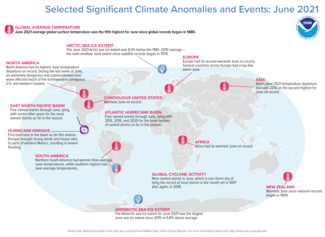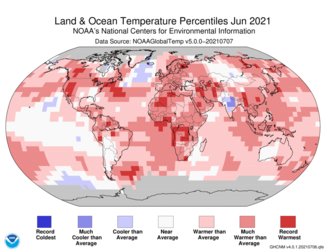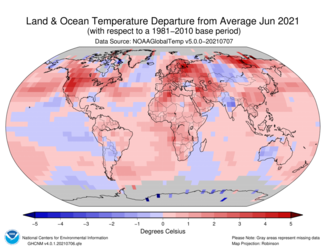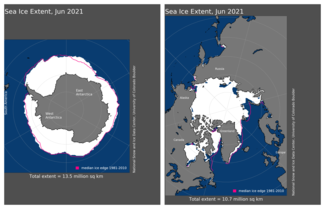Fifth-warmest June for the globe; global land surface was record warm

The global temperature for June 2021 was the fifth highest for June in the 142-year NOAA record, which dates back to 1880. The year-to-date (January-June) global surface temperature was the eighth highest on record. According to NCEI’s Global Annual Temperature Rankings Outlook, it is very likely that the year 2021 will rank among the 10 warmest years on record.
This monthly summary, developed by scientists at NOAA’s National Centers for Environmental Information, is part of the suite of climate services NOAA provides to government, business, academia and the public to support informed decision-making.
June Global Temperature
The June 2021 global surface temperature was 1.58°F (0.88°C) above the 20th-century average of 59.9°F (15.5°C) — the fifth-warmest June in the 142-year record. June 2021 marked the 45th consecutive June and the 438th consecutive month with temperatures, at least nominally, above the 20th-century average.
The global land-only surface temperature for June 2021 was 2.56°F (1.42°C) above average and the highest June land-only surface temperature on record, besting the previous record set in 2019 by 0.20°F (0.11°C). This was mainly driven by the very warm Northern Hemisphere land, which also had its highest June temperature at 3.04°F (1.69°C) above average.
Temperatures were much warmer than average across parts of North America, northern South America, Europe, Africa and across parts of Asia, the Pacific, the Atlantic and Indian oceans. Temperatures were cooler than average across parts of the northern Atlantic Ocean, India and the eastern Pacific Ocean.
North America had its warmest June on record. During the last week of June, an extremely dangerous and unprecedented heat wave affected much of the northwestern contiguous U.S. and western Canada with maximum (daytime) temperatures surpassing 100°F (38.0°C), not typical for the region.
Africa’s June 2021 temperature was the highest for June on record, surpassing the now second-warmest June set in 2020. The last three Junes (2019, 2020 and 2021) are the three warmest Junes on record.
Europe and Asia (tied with 2010) had their second-warmest June on record. South America and Oceania also had above-average June temperatures; however, their temperature departures didn’t rank among the 10 warmest on record.
Tropical Cyclones
The Atlantic hurricane basin had above-average tropical storm activity so far this season with four named storms through June 2021, tying with 2012, 2016, and 2020 for the most named storms through June.
In the East Pacific, there were five named storms through June. This ties with seven other years for the most on record through the month of June. The West Pacific basin had near-normal named storms in June. Globally, there were nine storms in June, which is one storm short of tying the record set in 1997 and, again, in 2018.
June Sea Ice
The Arctic sea ice extent averaged 4.14 million square miles in June 2021, which is 405,000 square miles — about the size of the South American country of Paraguay — below the 1981-2010 average. This was also the sixth-smallest June extent in the 43-year record, according to an analysis by the National Snow and Ice Data Center (NSIDC) using data from NOAA and NASA. The ten smallest June sea ice extents for the Arctic have occurred since 2010.
The Antarctic sea ice extent during June 2021 was above average and the largest for June since 2015 at 5.20 million square miles. During the month, sea ice grew at a slightly above-average pace.
For a more complete summary of climate conditions and events, see our June 2021 Global Climate Report.







